|
More than 230 bird species have been documented in Capitol Reef National Park. Some species are seasonal residents, others pass through during migration, and a few make this their home year-round. Popular locations for bird watching in the Fruita area include the Fremont River Trail that passes by the campground and orchards, the trees around the Ripple Rock Nature Center, the picnic area, and the riparian vegetation along Sulphur Creek. A complete bird checklist can be downloaded. The following provides information on some of the interesting birds of Capitol Reef: 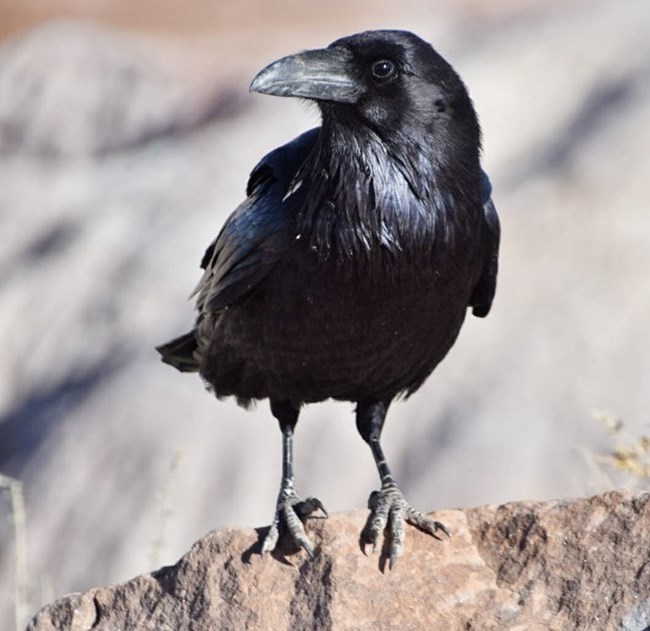
NPS / Andy Bridges Common RavenRavens (Corvus corax) are found in nearly every habitat across western and northern North America and are common in the park. Look for them soaring along the cliff walls. Breeding pairs form territories and try to exclude other ravens. Excellent and acrobatic fliers, ravens may perform sudden rolls, wing-tucked dives, and even drop objects and catch them in midair. In the park, they nest on cliff ledges or holes. Ravens are typically seen alone or in pairs, except at food sources where they may form groups. Their diet is varied and includes carrion (dead animals), small mammals, insects, small birds, eggs, invertebrates, fish, grains, fruits, and unattended human food. Ravens are among the smartest of all birds, able to solve problems and can mimic the calls of other birds. 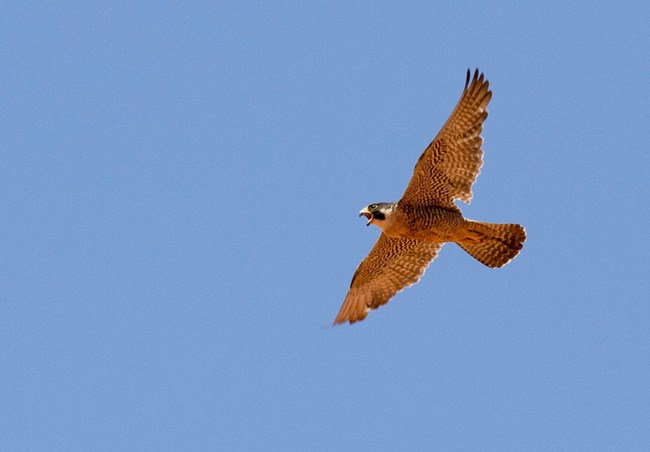
NPS / Andrew Kuhn Peregrine FalconPeregrine falcons (Falco peregrinus) are among the most widespread birds in the world, found on all continents except Antarctica. They also have one of the longest migrations of any North American bird; individuals may travel from the tundra of Canada to South America and back each year. These falcons are rare in the park but at times are seen nesting on cliff ledges. The widespread use of DDT from the 1940s-1970s caused a drastic reduction in their numbers. By 1999, due to a ban on DDT and reintroductions, the species had recovered and was removed from the federal endangered species list. Peregrine falcons hunt from a perch or high in the air, attacking prey in midair at high speeds. They are the world's fastest bird, capable of attaining speeds of over 200 mph, which aids them in hunting small and medium-sized birds. They have a slim body, pointed wings, a short tail, and a prominent dark mustache. The prairie falcon, a similar bird found in the park, is browner in color with dark patches where the wings meet the body on the underside of the bird. 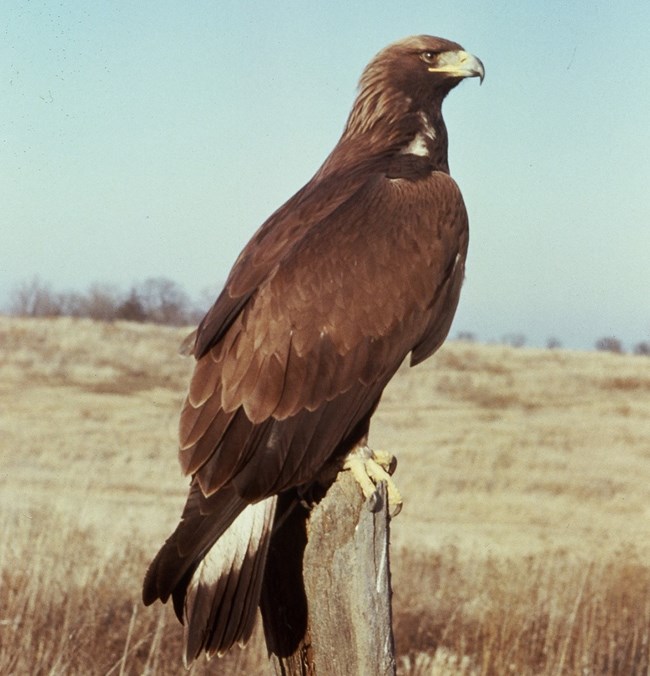
NPS Golden EagleThe golden eagle (Aquila chrysaetos) inhabits western North America, including the park. This large, powerful bird of prey has a wingspan of up to 7 feet (2.1 meters). They are typically found in open country, especially in mountainous or hilly terrain. In the park, look for eagles soaring overheard or perched high on a cliff. Using their keen vision to spot prey below, they dive quickly to catch it by surprise with long sharp talons. Primary prey is small to medium-sized mammals such as rabbits and marmots. Two eagles hunting together may take larger prey, including small deer or pronghorn. Pairs are monogamous, mating for life, and often use the same nest year after year. Nests are more often constructed on cliff faces than in trees and may include interesting items such as antlers, bones, and barbed wire. 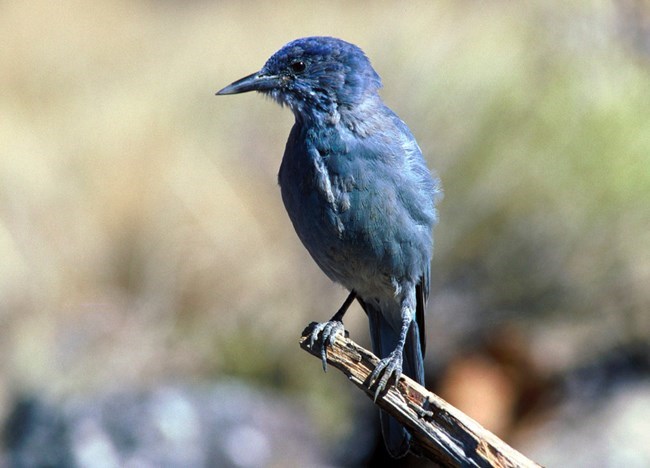
NPS / Parashant National Monument Pinyon JayThe pinyon jay (Gymnorhinus cyanocephalus) is found in pinyon-juniper woodlands throughout much of the western U.S., including Utah. It is fairly common and a year-round resident. Overall these birds are dusty-blue colored, with short tails. A highly social bird, pinyon jays typically travels in flocks of a few birds to hundreds. Flocks consist of multiple breeding pairs and the offspring of those pairs from previous nesting seasons. Pinyon jays will feed on berries, grains, and insects but they prefer pinyon pine seeds. Pinyon jays and pinyon pines have co-evolved in a mutually beneficial way. Each jay stores thousands of seeds each year, and has such a good memory that it can remember where most of them were cached. Forgotten seeds may sprout as new trees, helping to create a new generation of pinyon pines. 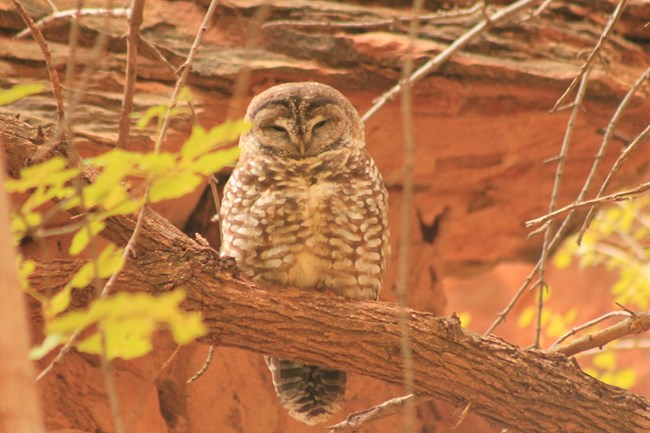
NPS / S. Cotrell Mexican Spotted OwlMexican spotted owls (Strix occidentalis lucida) live in parts of Utah, Colorado, Arizona, New Mexico, Texas, and northern Mexico. The species has been federally listed as threatened since 1993 due to habitat loss, degredation, and fragmentation. This owl inhabits deep narrow canyons within the park where it is a rare, permanent resident. Common prey are rodents such as woodrats, mice and voles, but they will also consume bats, birds, reptiles, and arthropods. They nest on cliff ledges and caves, in stick nests built by other birds, on debris platforms in trees, and in tree cavities. They have one of the lowest clutch sizes among North American owls with one to three eggs laid, two being the most common. If you happen to come across an owl while exploring the park, keep your distance. A spooked owl may fly away, making it prone to attack by competing birds of prey like ravens or eagles. 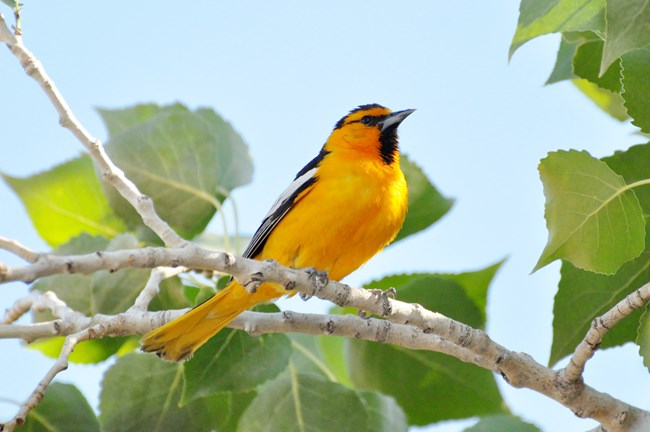
NPS / Andy Bridges Bullock's OrioleThe Bullock's oriole (Icterus bullockii) is a summer resident in Utah, where it is typically found in open woodlands, brushy areas, and riparian zones. Bullock's orioles are common in the park, especially in the Fruita area, where their bright colors flash among the trees. Their hanging, pouch-shaped nests are built in trees high above the ground. Nests are made from a variety of fibers including hair, twine, grass, and wool and are lined with down, hair, or feathers. Orioles eat invertebrates (including many caterpillars), ripe fruit (especially cherries), and nectar. Males are readily identified by their bright orange, black, and white feathers. The song, which both sexes sing, is a mix of whistles and harsh notes. 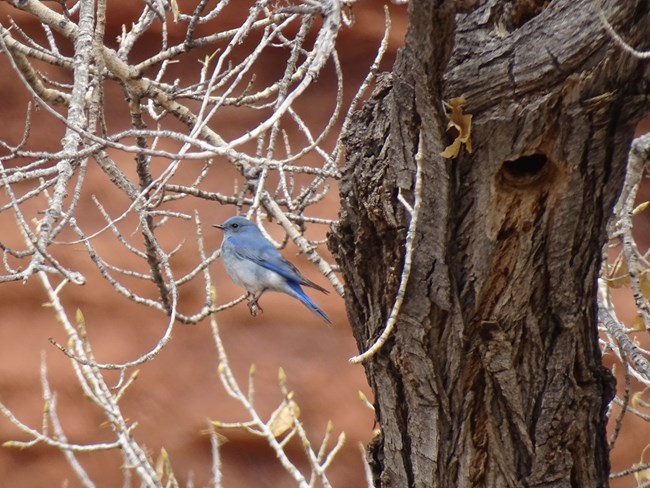
NPS / S. Cotrell Mountain BluebirdThe mountain bluebird (Sialia currucoides) can be found across the western U.S. and is an uncommon year-round resident of the park. The best place to look for these birds is around the pastures of the Fruita area where they may be hovering over the grass in search of insects to eat. In the winter, juniper berries and other seeds are an important source of food. Bright blue above and pale blue below, males are easy to distinguish from western bluebirds which have a rusty colored "vest." Many birds, including the mountain bluebird, are highly vulnerable to changes in climate, making places such as Capitol Reef important refuges. 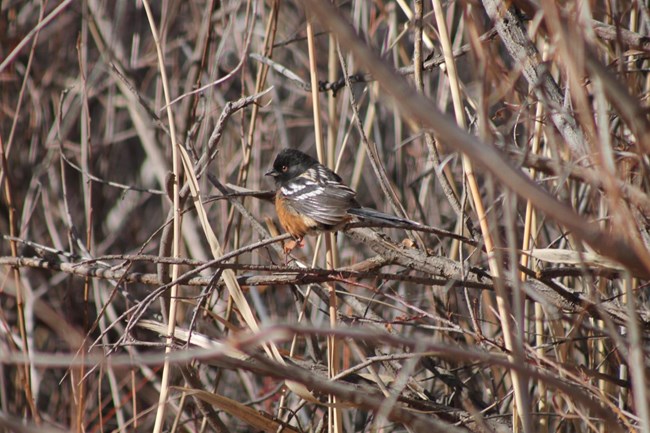
NPS / S. Cotrell Spotted TowheeOften heard before it is seen, the spotted towhee (Pipilo maculatus) scratches the ground and hops around in dense brush as it forages for insects, seeds, and berries. It is a common bird in the shrub and grasslands, as well as the riparian areas around Fruita. They nest in bushes, less than five feet from the ground, where they may raise two broods of 3-5 young in a season. Drought conditions and a prediction for a drier intermountain west will likely push this species away from riparian zones and towards sagebrush shrublands.
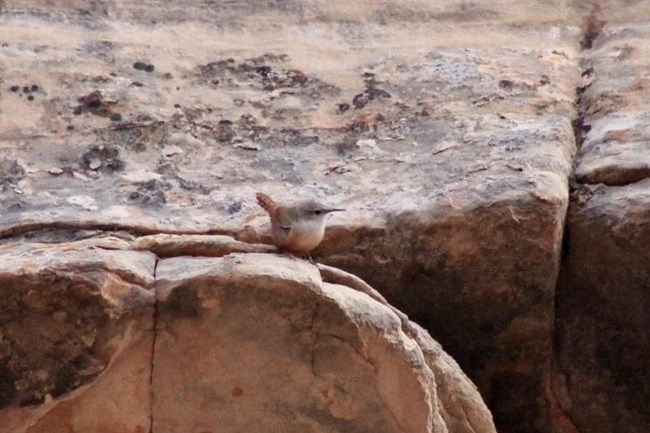
NPS / S. Cotrell Canyon WrenThe canyon wren (Catherpes mexicanus) is found in the arid mountains and canyon lands of the western U.S. It is fairly common in Utah including the canyons, cliffs, and rocky outcrops in the park. One of the least studied birds in North America due to their preference for rugged landscapes, canyon wrens are territorial and non-migratory. Rusty-brown overall with a more orange tint to the tail, it has a distinctive clean white throat. A long, slightly curved bill and flat head enable it to reach deep into crevices to find insects and spiders, its primary prey. Nests are a cup made of twigs and other coarse materials placed in caverns, crevices, or attached to a rock face, protected above by a ledge. Its musical, cascading song is unique and memorable. 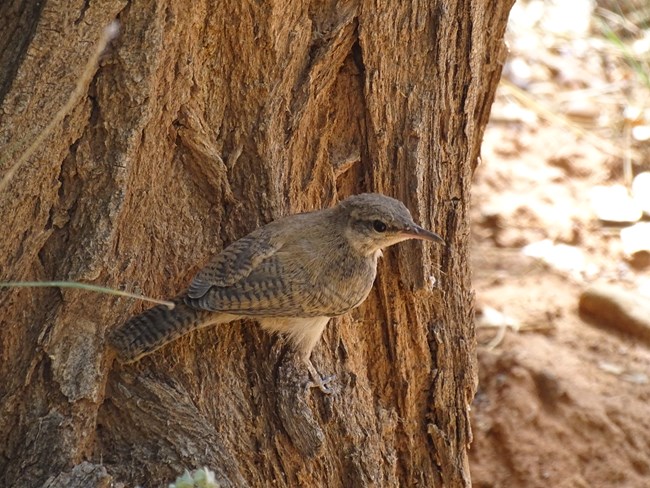
NPS / E. Van Ness Rock WrenThe rock wren (Salpinctes obsoletus) is a common resident of arid and semi-arid habitats in the western U.S. It is migratory and abundant in the park during the breeding season. The rock wren inhabits rocky slopes and outcrops at elevations as high as 10,000 ft (3050 m). It has a pale gray back, faintly striped breast, long tail, and long, thin bill. Both sexes build a walkway of small, flat stones that leads to the cupped nest located in a rock crevice or hole. It uses its long bill to probe into narrow crevices to find insects and spiders, its primary prey. The rock wren can frequently be seen bobbing up and down, especially when alarmed. Its song is a mix of buzzes and trills. Territorial males often alternate songs with their male neighbors.
Visit our keyboard shortcuts docs for details
Some male rock wrens (Salpinctes obsoletus) can perform over 100 different songs. |
Last updated: February 13, 2024
